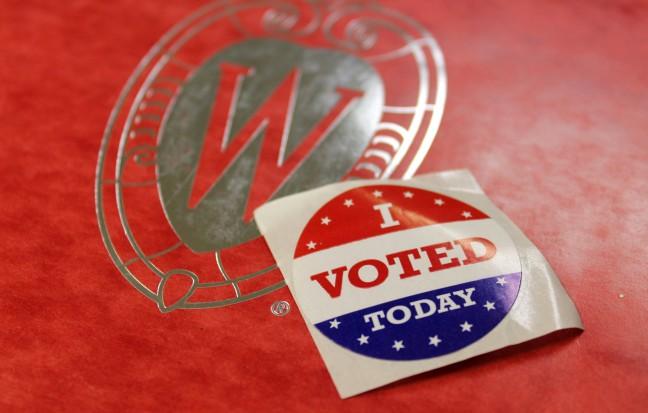In light of a recent battleground state survey, University of Wisconsin political science experts contend new, young voters in Madison are key in Sanders’ lead and the 2020 general election.
The UW Election Research Center conducted its first major poll in mid-February — surveying the battleground states Wisconsin, Pennsylvania and Michigan. ERC Director Barry Burden said these states were chosen because they all flipped in 2016 from Democrat to Republican after decades of consistently voting Democratic in presidential elections.
Since the states all flipped red by narrow margins, Burden said they will most likely decide the presidency in 2020. In Wisconsin’s survey results, Bernie Sanders pulled ahead with 30% of the Democratic vote for the April 7 presidential primary, outpacing all other Democratic candidates in the state by a sizable margin.
“One of the striking findings was how well Bernie Sanders is doing in Wisconsin,” Burden said. “He did win the primary four years ago, so it might not be surprising that he might be in the lead again, but the size of that gap is bigger than some people would have expected.”
Despite Sanders’ current lead, Burden said the survey’s results place all Democratic candidates in extremely close head-to-head races with Donald Trump in the general election. While the Democratic candidates have a slight edge over Trump, Burden said the general election in Wisconsin will be extremely close — regardless of the Democratic nominee.
Burden said the key to the Democrats’ slight edge is new voters, who make the difference in keeping Democrats even with — or slightly ahead of — Trump in the general election.
While Trump’s support in Wisconsin is just as strong as it was in 2016, Burden said the general election matchups remain close because people who did not vote in 2016 are strongly supportive of all of the democratic contenders compared to Trump. Burden said African American new voter turnout, especially in Milwaukee, could largely influence the Democrat’s success.
“[In 2016] there were big drops in turnout, especially in the Milwaukee area, among black voters, and that hurt Clinton,” Burden said. “I think that group of voters will be reenergized … we don’t know how far that will go, and turnout will be up about everywhere in the state, but I think more sharply among African American voters.”
Burden said another major source of new voters is Madison. Burden said Dane County and Madison are the fastest growing regions in Wisconsin, meaning new residents could make or break the general election for the Democrats. There are people who can vote now who weren’t old enough to last election, Burden said.
Burden said the youth vote is another population within Madison’s new residents that will be key in the general election. Burden said young voters will carry a lot of weight in the region, contributing to Madison’s population and keeping Wisconsin a battleground state.
“It’s partly the growth of the Madison area that keeps Wisconsin a swing state,” Burden said. “Other parts of the state are more Republican, and it is really the balancing of Madison in part that keeps it purple.”
In Madison, Burden said many of the new 18, 19 and 20-year-olds who are participating for the first time lean towards the Democrats, particularly towards Sanders. The ERC’s survey found 55% of Sanders’ base is comprised of young voters ranging from the ages of 18 to 29.
Burden said relying on a youth demographic is unusual for a major party candidate. Burden said this demographic poses a challenge for Sanders to ensure his youth base shows up as strong in the voting booth as they are in the poll numbers.
“Sanders is putting together a kind of unusual coalition that hasn’t worked well for other candidates,” Burden said. “He’s relying really heavily on young people, but young people are traditionally less likely to vote in every kind of election, often by large margins.”
ERC Contributor and UW Political Science Professor David Canon said Sanders is the only candidate making a pitch to bring new voters to the polls for the Democratic party.
But, Canon said there is not strong evidence from the first few primaries to support this assertion, given new voter turnout has not surged significantly. Canon and Burden said relying on the youth vote is a risky strategy because their political track record of voting is unreliable compared to older voters.
“There is a fairly linear relationship between the older you are the more likely you are to vote,” Canon said. “So that is just a very long-standing demographic reality that Bernie Sanders is facing when he does base a lot of his vote on the younger voters.”
Where Sanders is pulling strongly with youth, Canon noted Democratic candidate Joe Biden is doing better with older voters who are more likely to show up to the polls.
Canon said the strong African American voter base Biden carries is another aspect that may come into play in Wisconsin, giving him an edge over Sanders.
“The conventional wisdom had been for the early part of the campaign — that Joe Biden’s real base was with African Americans voters — has been a spot of weakness for Bernie Sanders,” Canon said.
Burden and Canon both agreed that if Sanders can bring out the age demographic from 18 to 29-year-olds, it would be a huge factor in his success in both the Democratic primaries and the general election.
Burden said Sanders must sustain the energy of the youth base for a chance to win the nomination and continue to foster that energy even more so for the general election. Burden said youth voters are essential in the general election — serving as the most important moving part in how Sanders does in Wisconsin.
“If [Sanders] is going to be successful in the primary, and especially in the general election, he will need to turn out lots of young voters in a way other Democrats have not managed to do,” Burden said.


